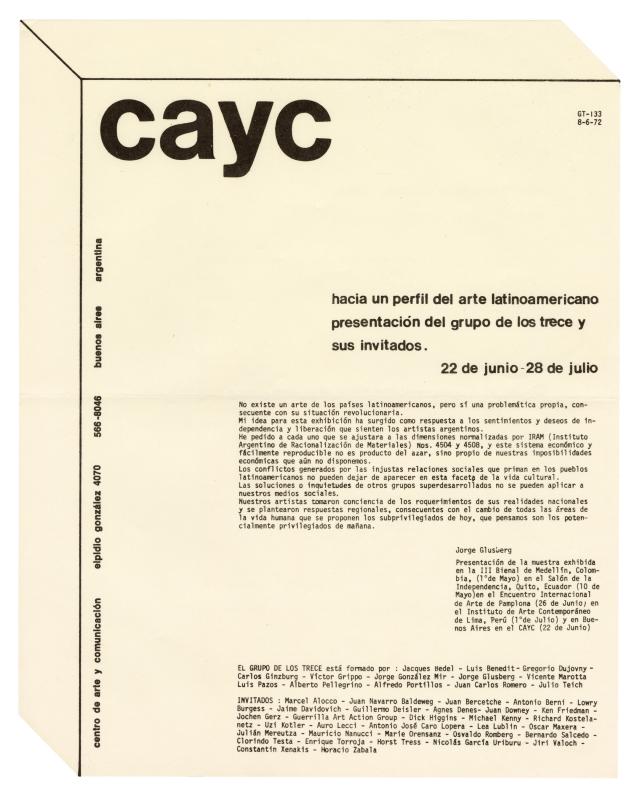Ever since it was founded, the CAYC (Centro de Arte y Comunicación), helmed by the cultural promoter, artist, and businessman Jorge Glusberg, was intended as an interdisciplinary space where an experimental art movement could flourish. The establishment of collaborative networks connecting local and international artists and critics played a key role in this process. The exhibitions shone a light on these exchanges, in which overviews of trends or individual artists introduced the innovations of international contemporary art and made Argentine and Latin American artists better known on the global scene.
Hacia un perfil… showed works in which Argentinean and international artists pondered the political situation that was common to all their countries. The exhibition provided a perspective on art and the Grupo de los Trece’s ideology in a concise overview of contemporary regional art. The CAYC’s version of arte de sistemas (systems art) not only referred to international process art; its political stance, absorbed over the course of its many productions and presentations, gave it an identity of its own and associated it with a regional identity. In his introduction to the exhibition, Glusberg said: “There is no Latin American art as such, but the region’s individual countries do share a common problem in terms of their revolutionary situation” (GT-133 [doc. no. 1476312]).
The list of participating artists from Argentina and other countries varied from one version of the exhibition to another, from that year to next, but the concept referred to in the title remained the same. This exhibition confirmed a change of direction in the center’s discourse that had, in its earliest years, relied heavily on the promising relationship between art and technological development.
The travels referred to in this newsletter provide insight into the drastic change taking place at the CAYC at that time, and the beginning of a new phase in its association with critics, cultural promoters, institutions, and circuits in various different places in Europe and the Americas. The CAYC frequently made changes to the list of participants in its exhibitions when they were presented at other institutions. The center’s presentation in Zagreb—a city which, at the time, was part of the Socialist Federal Republic of Yugoslavia—was significant under the circumstances, given the Cold War and the introduction throughout Latin America of the Theory of Dependence, which explained that the poverty the region’s countries were experiencing was a result of the oppression exerted by the major world powers. The eagerness to create links between Latin American and Eastern European art was a fundamental part of the CAYC’s strategy for international exchange. The center advocated a “unity of strengths” among local art scenes in what were considered Third World countries. That is, what Glusberg saw as a form of art that expressed the specific problems these countries had in common.

